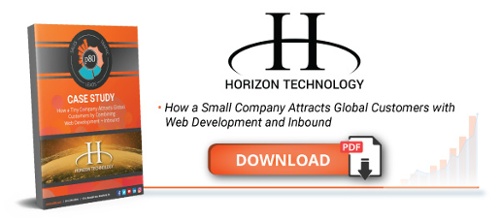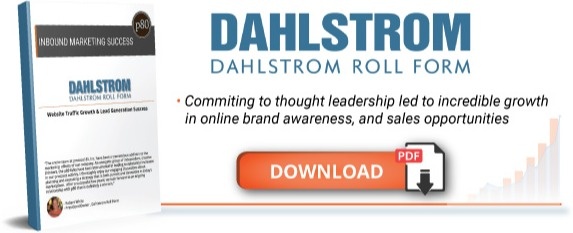Inbound Marketing Blog
for Manufacturers and Healthcare Companies
[DATA] Why You Must Invest in Digital Marketing -- & Stick to It

You’ve worked with the folks at Customer Y and Customer X for 25 years each, and they still provide a nice chunk of revenue.
Your business has been in the B2B/industrial game for 50-100 years, and the brand is already “well known” (somewhere, at least).
Trade shows and sales visits to the prospect’s facility are what your sales team knows and is good at. (Though that pesky pandemic sure made it hard.)
So, why invest in digital marketing?
Many of the shifts in buying, selling, and marketing that COVID caused aren’t going away. In fact, they only reinforced the value of remote-first B2B inbound marketing and sales tactics.
Are you new to the idea of digital/inbound marketing? Did you try it before and watched it fail? Here’s why you need to invest (or reinvest) in a digital content marketing timeline – today:
Gauging Inbound vs. Outbound Marketing ROI
For the sake of this article, we’re focusing on why inbound marketing is important. Especially in digital marketing, inbound is a more reliable, customer-friendly way to engage buyers today. (Your buyers agree.)
- Inbound marketing is a non-interruptive philosophy centered around getting specific, relevant prospects coming to your site willingly. It includes content marketing – blogging, social media, email, etc. – and both paid and free search engine visibility efforts.
- Outbound marketing is the interruptive, traditional use of “push” messaging to cast a wide net in hopes of landing a few fish. Examples include cold calling, cold emailing, LinkedIn InMail messages, and some trade show activities.
In virtually any industry, inbound comes with far more ROI potential than outbound marketing (as in, 61% less cost per lead). Most B2B buyers have long sales cycles and have found ways to block annoying outbound tactics that reach them before they’re ready to buy. Inbound, however, educates them first with meaningful content, long before a sales pitch comes.
Why Invest in Digital Marketing? A Side-by-Side Comparison
Many companies – inbound agencies included – foolishly avoid any talk of pricing on their websites. This makes it hard to know what to budget for an inbound marketing campaign.
As a point of reference, we bill most of our inbound clients $5,000-$10,000/month. There are outliers in both directions. For a full-service firm that helps small-to-midsize B2Bs, that’s considered mid-range inbound marketing pricing.
Investment of $4,000/Month vs. Do Nothing
There’s no shortage of inbound marketing case studies that show crystal-clear impact of content on traffic, leads, and sales. But let’s strip away the feel-good storytelling and simply analyze a standard inbound/content marketing investment of $4,000/month vs. sticking with outbound or no marketing:
$4,000/Month
Below is real data from a metal parts manufacturer that invested $4,000 a month in inbound marketing, and how long it took to grow website traffic:
 (A real-life manufacturer's web traffic growth in less than 2 years while investing $4,000/month)
(A real-life manufacturer's web traffic growth in less than 2 years while investing $4,000/month)
Perhaps the best part is that almost all of this growth came organically. “Organic traffic” is traffic you receive without directly paying for it (as you would with search engine or social media ads).
How do you grow traffic, leads, and sales for virtually free, save for labor costs? A typical monthly investment in full-service inbound may be:
- 4 blog posts
- 4-12 posts on each social media account
- 1 webpage or premium offer (i.e. e-book)
- 2 email newsletters
- 1 miscellaneous tactic (i.e. video tour, guest article in third-party publication)
- Ongoing SEO & analytics
- Whatever will engage your ideal buyer!
(p80 Resource: How Long Does B2B SEO Take to Rank in Google?)
In the example above, the results may look impressive, but slow. It’s true that inbound marketing is a long-term investment that requires patience – especially if you’re starting with low traffic. (Prior to using inbound, this example company was recording months with only 40 unique visitors on its site.)
Improving Google Search rankings and traffic through SEO – search engine optimization – requires you to build out a “library” of relevant, high-quality content. And initial ramp-up requires a few months for:
- B2B buyer research
- Content & SEO audits of the current website
- Keyword & competitor analysis
- Strategy & calendar development
Pulling the plug on an organic-focused campaign that hasn’t brought results in months 1-6, or starting a campaign without proper research and inbound marketing goal setting, is downright silly.

Do Nothing
Sure, you can hope that your traditional tactics continue to help you scrape by. And maybe they will for a few more years. But what about when …
- A big, longtime customer suddenly leaves you?
- Your buyers start attending fewer trade shows, or only attend virtually?
- Buyers ignore your cold outreach in favor of researching solutions on their own?
One or more of these may already be happening to you. By ignoring the needs of your current and next generation of buyers, you’ll fall further behind your competition.
This is true for virtually any industry – even yours. Inbound marketing for industrial manufacturers is a real thing – we’ve seen success stories in:
- Roll forming
- Powder metallurgy
- Flexographic printing equipment
See – there’s no excuse for scoffing at ideas like blogging and social media marketing!

Investing $5,000/Month vs. $10,000/Month (or More)
Some B2B leaders, either because they’re frugal or they’re still skeptical of inbound marketing, start off with a small budget. Or, for the same reasons, they reduce the budget only 3-9 months after their initial investment.
While you’re surely more likely to increase leads and traffic vs. the “do nothing” crowd, the results will be much slower.
Meanwhile, higher monthly investment (and, sometimes, paid search/social advertising) can accelerate growth even more.
Here’s another B2B content marketing example. This hinge manufacturing company started off with an approximately $5,500 monthly budget. After 18 months of a happy partnership with an agency, the manufacturer decided to ramp up its investment to $10,000:

Traffic (shown above) grew marginally for that initial 18-month phase, while leads (not shown) increased a little more sharply. But, at the start of 2021, you can see that traffic took off – and leads increased even more dramatically.
The lesson? Inbound takes an investment of both time and money. Your budget should reflect how quickly you want to grow.
3 Ways Meddlesome Stakeholders & Unqualified Teams Derail Investment
Money isn’t everything. There are other reasons digital marketing investments can stall, whether the investment is $5K, $10K, or $25K:
Captain Impatient
Sadly, an impatient stakeholder can abort a mission right before your KPIs were about to skyrocket.
Did you know at least 60% of all blog traffic arrives 1+ months after publishing? Any digital marketing agency or staffer that promises instant organic results is lying to you.
The more high-quality pages you create over time, the better your site will rank in Google and the more great-fit leads you’ll earn. These blog, services, and landing pages don’t appear from thin air. You’ll have to invest enough to get output capable of meeting your annual B2B content marketing goals.
For inbound agencies, seeing at least one client per year cancel in months 1-12 is as predictable as knitted socks from Grandma on Christmas.
Don’t let anyone in your organization be the progress-halting Captain Impatient or his evil twin below (or their three cousins):
Dr. Indecisive
Sudden sparks of inspiration are great, but not when the ideas are based on zero strategy or data. And not when you haven’t finished what was due last July.
Consistently overriding previously agreed-upon strategy – especially early in a campaign – is a bad omen for results. When decision makers frequently change their mind on content topics or targeting strategy, it pushes back milestones and increases overhead costs.
Most successful inbound-ers follow a quarterly activity map, only deviating for special circumstances.
The Stitched-Together Squad
The final – and most ominous – reason a large investment can fail is a lack of skills, understanding, or time.
Inbound marketing goes far beyond colors and logos and even basic demographics. Can your team:
- Understand how to reach great-fit buyers through SEO/keyword research and web design?
- Write content that attracts prospects and search engines, with conversion rates in mind?
- Spare the time to actually do these?
If your content folks produce half-hearted, sales-y content pieces with no Google optimization, the amount you invest won’t matter much.
Why Invest in Inbound Marketing? Because You Have No Choice
Because of how inbound marketing works, it takes 6-12 months to move the needle, even if you’re investing $10K. When you only dip a toe in with $1K-$2K, you’re in for an extra-long wait for results.
Because inbound marketing’s ROI is so substantial (when the right folks are running it), it’s 100% worth your long-term attention and dollars. For more proof that inbound marketing does work, see these full case studies:
(Editor's note: This post was originally published in February 2022 and was recently updated with fresh insights.)
Our Blogs, Direct to Your Inbox!
How to Audit your Online Marketing
If you are executing digital marketing, congratulations! You are most likely already one step ahead of your competition, and making strides to meaningfully connect with prospects online. But, how do you know if you’re seeing continual success year over year, and improving your metrics?
Without the tools in place to analyze and benchmark your efforts, it is impossible to scale your online marketing and ensure continuous success.



